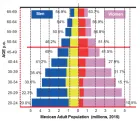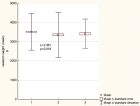Abstract
Editorial
Retrosternal goiter mimicking asthma: A diagnostic challenge
Yiannakopoulou Eugenia*
Published: 10 January, 2020 | Volume 4 - Issue 1 | Pages: 001-002
Asthma is a chronic respiratory disease characterized by chronic airway inflammation. Common manifestations of asthma include wheezing, chest tightness, cough, shortness of breath. Diagnosis of asthma requires clinical documentation of respiratory symptoms, exacerbation of symptoms following exposure to triggers, as well as demonstration of expiratory airflow obstruction. Wheeze is a continuous sound, lasting longer than 0.25 s that is produced by oscillation of opposing airway walls [1,2]. Wheezing, although a typical symptom of asthma, can also be caused by other diseases. Apart from asthma, wheezing can be due to extra-thoracic upper airway obstruction, intrathoracic upper airway obstruction, lower airway obstruction.
Benign multimodal goiter is a common disease, that rarely causes upper airway obstruction. Retrosternal goiter should be taken into account the differential diagnosis of upper airway obstruction [3]. The respiratory symptoms of a retrosternal goiter may be masked for years due to the slow growth of the goiter. Patients commonly complain of respiratory symptoms if tracheal diameter is narrowed more than 50% from the normal size. Respiratory symptoms may be suddenly precipitated by spontaneous or traumatically induced bleeding into the substernal goiter, as well as by tracheal infections [4]. Clinical management of this condition is really challenging. Diagnosis is also not straightforward, as clinical suspicion is needed. There are cases of retrosternal goiter mimicking asthma that remain undiagnosed for many years. Retrosternal goiter should be taken into account in the differential diagnosis of patients diagnosed as suffering from asthma, and presenting no improvement despite medical therapy. In addition, it should be taken into account that sudden gland enlargement due to hormonal changes might lead to life threatening upper airway obstruction with clinical picture similar to bronchial asthma attack [5]. In a recent very interesting case report, the authors present a case of a pregnant woman in the second trimester who presented with an acute airway obstruction due to the enlargement of a retrosternal goiter [3].
Goiters are the more common masses of the superior mediastinum [6,7]. Commonly, retrosternal goiter is due to the extension in the thorax of a cervical goiter. However, rarely, it may represent primary disease due to the growth of ectopic thyroid tissue. In addition, retrosternal goiter may develop in patient submitted to thyroidectomy due to cervical multinodular goiter [8]. Although retrosternal goiters are commonly asymptomatic, symptoms may include dyspnea, stridor, hoarseness, dysphagia, superior vena cava syndrome, transient ischemic attacks, cerebral edema, Horner’s syndrome, and thyrotoxicosis [4]. Diagnosis could be verified by neck and chest radiography, thorax CT and MRI. Chest radiography commonly shows a widened mediastinum with a superior mediastinal mass causing compression of the trachea as well as deviation of the trachea to the right. Mediastinal computed tomography reveals a mass that is extension of the thyroid gland. The presence of respiratory symptoms in a patient with retrosternal goiter is an indication for surgery. The majority of retrosternal goiters can be approached through a cervical approach [9,10].
Read Full Article HTML DOI: 10.29328/journal.aaai.1001017 Cite this Article Read Full Article PDF
References
- Loudon R, Murphy RL Jr. Lung sounds. Am Rev Respir Dis. 1984; 130: 663–673. PubMed: https://www.ncbi.nlm.nih.gov/pubmed/6385790
- Forgacs P. The functional basis of pulmonary sounds. Chest. 1978; 73: 399-405. PubMed: https://www.ncbi.nlm.nih.gov/pubmed/630938
- Loo GH, Wan Mat WR, Muhammad R, Azman M. Obstructive retrosternal goitre mimicking severe bronchial asthma in pregnancy. BMJ Case Rep. 2019; 12. PubMed: https://www.ncbi.nlm.nih.gov/pubmed/31383679
- Mack E. Management of patients with substernal goiters. Surg Clin North Am. 1995; 75: 377–394. PubMed: https://www.ncbi.nlm.nih.gov/pubmed/7747247
- Mettam IM, Reddy TR, Evans FE. Life-threatening acute respiratory distress in late pregnancy. Br J Anaesth. 1992; 69: 420-431. PubMed: https://www.ncbi.nlm.nih.gov/pubmed/1419458
- Cagli K, Ulas MM, Hizarci M, Sener E. Substernal goiter: an unusual cause of respiratory failure after coronary artery bypass grafting. Tex Heart Inst J. 2005; 32: 224-227. PubMed: https://www.ncbi.nlm.nih.gov/pubmed/16107122
- Vadasz P, Kotsis L. Surgical aspects of 175 mediastinal goiters. Eur J Cardiothorac Surg. 1998; 14: 393–397. PubMed: https://www.ncbi.nlm.nih.gov/pubmed/9845144
- Galiñanes EL, Caron N. Remnant large retrosternal thyroid goiter after thyroidectomy. Am Surg. 2012; 78: E222-223. PubMed: https://www.ncbi.nlm.nih.gov/pubmed/22472381
- Doulaptsi M, Karatzanis A, Prokopakis E, Velegrakis S, Loutsidi A, et al. Substernal goiter: Treatment and challenges. Twenty-two years of experience in diagnosis and management of substernal goiters. Auris Nasus Larynx. 2019; 46: 246-251. PubMed: https://www.ncbi.nlm.nih.gov/pubmed/30055961
- Torres A, Arroyo J, Kastanos N, Estopá R, Rabaseda J, et al. Acute respiratory failure and tracheal obstruction in patients with intrathoracic goiter. Crit Care Med. 1983; 11: 265-266. PubMed: https://www.ncbi.nlm.nih.gov/pubmed/6831895
Similar Articles
-
Atopic Conjunctivitis in Children: Influence of Treatment with Topical Cyclosporin 0.05% in the Quality of LifeCarlos Alberto Sánchez Salguero*,Álvaro Isidro Sánchez Chacón. Atopic Conjunctivitis in Children: Influence of Treatment with Topical Cyclosporin 0.05% in the Quality of Life . . 2017 doi: 10.29328/journal.haard.1001001; 1: 001-008
-
Features of Interferon and Cytokine Status in Atopic DermatitisOspelnikova TP*,Gevorkyan OV, Mironova TV,Andreeva SA,Kolodyazhnaya LV,Ershov FI. Features of Interferon and Cytokine Status in Atopic Dermatitis. . 2017 doi: 10.29328/journal.haard.1001002; 1: 009-014
-
The effects of early low dose exposures to the Environmental Estrogen Bisphenol A on the Development of Childhood AsthmaTerumi Midoro-Horiuti*,Randall M Goldblum. The effects of early low dose exposures to the Environmental Estrogen Bisphenol A on the Development of Childhood Asthma. . 2017 doi: 10.29328/journal.haard.1001003; 1: 015-027
-
Prevalence of reported drug allergy and its impact on Beta lactam use with financial and health implicationsJoanna Lukawska*,Abirami Murugesh-Warre#,Ranu Malhin#,Yogini Jani,Christopher Corrigan,David Walker,Harsha Kariyawasam. Prevalence of reported drug allergy and its impact on Beta lactam use with financial and health implications. . 2017 doi: 10.29328/journal.haard.1001004; 1: 028-035
-
Inducible Laryngeal Obstruction/Vocal Cord Dysfunction and the Role It Plays in Refractory AsthmaJay I Peters*,Jorge Villalpando,Sandra G Adams. Inducible Laryngeal Obstruction/Vocal Cord Dysfunction and the Role It Plays in Refractory Asthma. . 2017 doi: 10.29328/journal.haard.1001005; 1: 036-039
-
The use of Allergoids and Adjuvants in Allergen ImmunotherapyCelso Eduardo Olivier*. The use of Allergoids and Adjuvants in Allergen Immunotherapy. . 2017 doi: 10.29328/journal.haard.1001006; 1: 040-060
-
Lack of applicability of the Enterocyte Chloride ion secretion paradigm to the Pathology of Cystic FibrosisMichael L Lucas*. Lack of applicability of the Enterocyte Chloride ion secretion paradigm to the Pathology of Cystic Fibrosis. . 2017 doi: 10.29328/journal.haard.1001007; 1: 061-085
-
Cytokine Modulatory Effects of Sesamum Indicum Seeds Oil Ameliorate Mice with Experimental Autoimmune EncephalomyelitisMohammad Reza Javan*,Mohammad Reza Zamani,Saeed Aslani,Ghader Dargahi Abbasabad,Masoud Beirami Khalaj,Hamed Serati-Nouri. Cytokine Modulatory Effects of Sesamum Indicum Seeds Oil Ameliorate Mice with Experimental Autoimmune Encephalomyelitis. . 2017 doi: 10.29328/journal.aaai.1001008; 1: 086-093
-
Chemo-cytokines network is main target for control of Allergic asthmaSeyyed Shamsadin Athari*,Seyyede Masoume Athari. Chemo-cytokines network is main target for control of Allergic asthma. . 2018 doi: 10.29328/journal.aaai.1001009; 2: 001-002
-
Role of Serum Magnesium levels in Asthmatic with childrenSomashekar AR*,Ramakrishnan KG,Seyyed Vanitha Gowda. Role of Serum Magnesium levels in Asthmatic with children. . 2018 doi: 10.29328/journal.aaai.1001010; 2: 003-005
Recently Viewed
-
A Resurgence of the Idea of Hypertriglyceridemia and Lower Serum (HDL-C) as Predictive Factors for Insulin Resistance (IR) & Type 2 Diabetes Mellitus Development: A Narrative ReviewKulvinder Kochar Kaur*. A Resurgence of the Idea of Hypertriglyceridemia and Lower Serum (HDL-C) as Predictive Factors for Insulin Resistance (IR) & Type 2 Diabetes Mellitus Development: A Narrative Review. New Insights Obes Gene Beyond. 2025: doi: 10.29328/journal.niogb.1001022; 9: 001-012
-
Novel Mutation in Famous Gene Diseases in Red Blood CellsMahdi Nowroozi*. Novel Mutation in Famous Gene Diseases in Red Blood Cells. New Insights Obes Gene Beyond. 2025: doi: 10.29328/journal.niogb.1001023; 9: 013-020
-
Physical Performance in the Overweight/Obesity Children Evaluation and RehabilitationCristina Popescu, Mircea-Sebastian Șerbănescu, Gigi Calin*, Magdalena Rodica Trăistaru. Physical Performance in the Overweight/Obesity Children Evaluation and Rehabilitation. Ann Clin Endocrinol Metabol. 2024: doi: 10.29328/journal.acem.1001030; 8: 004-012
-
The Role of Genetic Mutations in the HPGD & SLCO2A1 Genes in Pachydermoperiostosis SyndromeShahin Asadi*,Arezo Zare,Sima Koohestani. The Role of Genetic Mutations in the HPGD & SLCO2A1 Genes in Pachydermoperiostosis Syndrome. J Genet Med Gene Ther. 2025: doi: 10.29328/journal.jgmgt.1001013; 8: 001-005
-
Estimation of Radiation Dose to Blood Vessels and Components from Medical Imaging Procedures: Current StatusKhalid M Aloufi*. Estimation of Radiation Dose to Blood Vessels and Components from Medical Imaging Procedures: Current Status. Arch Vas Med. 2025: doi: 10.29328/journal.avm.1001020; 9: 001-002
Most Viewed
-
Causal Link between Human Blood Metabolites and Asthma: An Investigation Using Mendelian RandomizationYong-Qing Zhu, Xiao-Yan Meng, Jing-Hua Yang*. Causal Link between Human Blood Metabolites and Asthma: An Investigation Using Mendelian Randomization. Arch Asthma Allergy Immunol. 2023 doi: 10.29328/journal.aaai.1001032; 7: 012-022
-
Impact of Latex Sensitization on Asthma and Rhinitis Progression: A Study at Abidjan-Cocody University Hospital - Côte d’Ivoire (Progression of Asthma and Rhinitis related to Latex Sensitization)Dasse Sery Romuald*, KL Siransy, N Koffi, RO Yeboah, EK Nguessan, HA Adou, VP Goran-Kouacou, AU Assi, JY Seri, S Moussa, D Oura, CL Memel, H Koya, E Atoukoula. Impact of Latex Sensitization on Asthma and Rhinitis Progression: A Study at Abidjan-Cocody University Hospital - Côte d’Ivoire (Progression of Asthma and Rhinitis related to Latex Sensitization). Arch Asthma Allergy Immunol. 2024 doi: 10.29328/journal.aaai.1001035; 8: 007-012
-
An algorithm to safely manage oral food challenge in an office-based setting for children with multiple food allergiesNathalie Cottel,Aïcha Dieme,Véronique Orcel,Yannick Chantran,Mélisande Bourgoin-Heck,Jocelyne Just. An algorithm to safely manage oral food challenge in an office-based setting for children with multiple food allergies. Arch Asthma Allergy Immunol. 2021 doi: 10.29328/journal.aaai.1001027; 5: 030-037
-
Snow white: an allergic girl?Oreste Vittore Brenna*. Snow white: an allergic girl?. Arch Asthma Allergy Immunol. 2022 doi: 10.29328/journal.aaai.1001029; 6: 001-002
-
Cytokine intoxication as a model of cell apoptosis and predict of schizophrenia - like affective disordersElena Viktorovna Drozdova*. Cytokine intoxication as a model of cell apoptosis and predict of schizophrenia - like affective disorders. Arch Asthma Allergy Immunol. 2021 doi: 10.29328/journal.aaai.1001028; 5: 038-040

If you are already a member of our network and need to keep track of any developments regarding a question you have already submitted, click "take me to my Query."


















































































































































